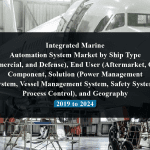OVERVIEW
The EVTOL Aircraft Market is currently valued at USD 1.2 billion in 2024 and will be growing at a CAGR of 52% over the forecast period to reach an estimated USD 23.4 billion in revenue in 2029. The electric Vertical Takeoff and Landing (eVTOL) aircraft market is experiencing a remarkable surge driven by technological advancements, urbanization pressures, and increasing demand for efficient urban air mobility solutions. These innovative aircraft, designed to take off and land vertically without the need for runways, promise to revolutionize short-distance travel in congested urban areas. With electric propulsion systems offering reduced emissions and noise levels compared to traditional aircraft, eVTOLs are not only environmentally friendly but also hold potential for cost-effective operations. As major players in the aviation industry, along with startups and tech giants, invest heavily in eVTOL development, the market is poised for exponential growth, paving the way for a future where urban air transportation becomes a reality.
The pressing need for efficient urban transportation solutions in densely populated areas is driving demand for alternatives to congested roadways. Secondly, advancements in electric propulsion technology have made eVTOLs increasingly feasible, offering reduced emissions and noise levels compared to traditional aircraft, aligning with growing environmental concerns and regulations. Additionally, supportive government policies and investments are incentivizing innovation and adoption within the industry. Moreover, the rise of urbanization and the accompanying need for faster, more convenient transportation options are further fueling interest and investment in eVTOL technology. Lastly, the emergence of new players in the aerospace industry, including startups and tech companies, is injecting fresh perspectives and resources into the market, accelerating its development and commercialization.
Table of Content
Market Dynamics
Drivers:
The pressing need for efficient urban transportation solutions in densely populated areas is driving demand for alternatives to congested roadways. Secondly, advancements in electric propulsion technology have made eVTOLs increasingly feasible, offering reduced emissions and noise levels compared to traditional aircraft, aligning with growing environmental concerns and regulations. Additionally, supportive government policies and investments are incentivizing innovation and adoption within the industry. Moreover, the rise of urbanization and the accompanying need for faster, more convenient transportation options are further fueling interest and investment in eVTOL technology. Lastly, the emergence of new players in the aerospace industry, including startups and tech companies, is injecting fresh perspectives and resources into the market, accelerating its development and commercialization.
Key Opportunities :
The eVTOL aircraft market presents a multitude of opportunities across various sectors. Firstly, there’s immense potential for urban air mobility services, offering efficient and convenient transportation solutions for commuters in densely populated areas, reducing travel time and congestion on roads. Additionally, eVTOLs could revolutionize emergency medical services by providing rapid aerial transportation for medical personnel and supplies, especially in hard-to-reach or disaster-stricken areas. Moreover, there are opportunities for cargo delivery services, where eVTOLs can offer fast and flexible delivery options for goods, particularly in urban environments where last-mile logistics pose challenges. Furthermore, the integration of eVTOL technology into existing transportation infrastructure, such as airports and helipads, opens up opportunities for partnerships and collaborations between traditional aviation stakeholders and eVTOL manufacturers. Lastly, the development of autonomous eVTOLs presents opportunities for unmanned aerial taxis and logistics applications, further expanding the market’s potential and ushering in a new era of aerial mobility.
Restraints :
Regulatory challenges and airspace integration issues present hurdles to widespread adoption, as aviation authorities work to establish safety standards and certification processes for this emerging technology. Additionally, concerns regarding infrastructure readiness, including the lack of suitable landing pads and charging infrastructure in urban areas, could impede the deployment of eVTOLs. Moreover, the high upfront costs associated with developing and manufacturing eVTOLs, coupled with uncertainties surrounding market demand and return on investment, may deter potential investors and manufacturers. Furthermore, technological limitations, such as battery energy density and flight range constraints, pose challenges to the scalability and commercial viability of eVTOLs for long-distance travel. Lastly, public acceptance and trust in autonomous air taxis and electric aviation remain uncertain, requiring extensive education and outreach efforts to address concerns regarding safety, noise, and privacy.
Regional Information:
• In North America, the eVTOL aircraft market is burgeoning, driven by a combination of technological innovation, supportive regulatory frameworks, and increasing urbanization. Major cities like New York, Los Angeles, and Dallas are embracing the potential of eVTOLs to alleviate traffic congestion and offer premium transportation services. Startups like Joby Aviation and established players like Boeing are leading the charge, investing heavily in research and development to bring their eVTOL prototypes to market. Moreover, initiatives such as NASA’s Urban Air Mobility Grand Challenge are fostering collaboration between industry stakeholders and regulatory bodies to accelerate the integration of eVTOLs into the national airspace system. However, challenges remain, including the need for infrastructure development and public acceptance, particularly in densely populated urban areas.
•In E urope, the eVTOL aircraft market is gaining momentum, driven by ambitious urban mobility initiatives and supportive regulatory environments. Cities like London, Paris, and Amsterdam are embracing eVTOLs as potential solutions to traffic congestion and air quality issues. Companies such as Lilium and Volocopter are spearheading development efforts, while collaborations with aviation authorities and urban planners are paving the way for integration into existing transportation systems. However, challenges remain, including the need for infrastructure upgrades and public acceptance.
• In the Asia-Pacific region, the eVTOL aircraft market is flourishing amidst rapid urbanization and increasing demand for innovative transportation solutions. Cities like Tokyo, Singapore, and Shanghai are exploring eVTOLs to address urban mobility challenges and enhance connectivity. Companies like EHang and Hyundai are leading the way with their eVTOL prototypes, supported by government initiatives and investment incentives. However, regulatory hurdles and airspace management complexities pose significant challenges to widespread adoption. Despite these obstacles, the Asia-Pacific region remains a hotbed for eVTOL innovation, with immense potential to transform urban transportation landscapes.
Recent Developments:
• June 2021 – Helisul Aviation, a Latin American helicopter operator ordered Eve Urban Air Mobility’s 50 electric VTOL air taxis for urban air mobility operations in Brazil. The deliveries are expected to begin by 2026.
• June 2021 – Eve Urban Air Mobility received an order for 200 four-passenger eVTOL air taxi from Halo, a Directional Aviation brand created by the alignment of Associated Aircraft Group (AAG) in the U.S. The deliveries of the aircraft are expected to begin by 2026.
Key Market Players:
Joby Aviation, Lilium, Volocopter, EHang, Airbus, Bell, Boeing, and Kitty Hawk.
Frequently Asked Questions
1) What is the projected market value of the EVTOL Aircraft Market?
– The EVTOL Aircraft Market is expected to reach an estimated value of USD 23.4 billion in revenue by 2029.
2) What is the estimated CAGR of the EVTOL Aircraft Market over the 2024 to 2029 forecast period?
– The CAGR is estimated to be 52% for the EVTOL Aircraft Market over the 2024 to 2029.
3) Who are the key players in the EVTOL Aircraft Market?
– Joby Aviation, Lilium, Volocopter, EHang, Airbus, Bell, Boeing, and Kitty Hawk.
4) What are the drivers for the EVTOL Aircraft Market?
– The demand for efficient urban transportation is increasing due to the need for alternatives to congested roads. Advancements in electric propulsion technology make eVTOLs feasible, aligning with environmental concerns. Government policies and investments in the industry are incentivizing innovation.
5) What are the restraints and challenges in the EVTOL Aircraft Market?
– Regulatory challenges, airspace integration issues, infrastructure readiness, high upfront costs, technological limitations, and public acceptance of autonomous air taxis (eVTOLs) pose obstacles to widespread adoption of electric aviation. These issues include safety standards, certification processes, high upfront costs, market demand uncertainties, and public acceptance concerns regarding safety, noise, and privacy.
6) What are the key applications and offerings of the EVTOL Aircraft Market?
– Key applications of eVTOL aircraft include urban air mobility for passenger transportation, emergency medical services for rapid aerial response, cargo delivery for efficient logistics solutions, and aerial surveillance for security and monitoring purposes.
7) Which region is expected to drive the market for the forecast period?
– North America is expected to have the highest market growth from 2024 to 2029
Why Choose Us?
Insights into Market Trends: Global Market Studies reports provide valuable insights into market trends, including market size, segmentation, growth drivers, and market dynamics. This information helps clients make strategic decisions, such as product development, market positioning, and marketing strategies.
Competitor Analysis: Our reports provide detailed information about competitors, including their market share, product offerings, pricing, and competitive strategies. This data can be used to inform competitive strategies and to identify opportunities for growth and expansion.
Industry Forecasts: Our reports provide industry forecasts, which will inform your business strategies, such as investment decisions, production planning, and workforce planning. These forecasts can help you to prepare for future trends and to take advantage of growth opportunities.
Access to Industry Experts: Our solutions include contributions from industry experts, including analysts, consultants, and subject matter experts. This access to expert insights can be valuable for you to understand the market.
Time and Cost Savings: Our team at Global Market Studies can save you time and reduce the cost of conducting market research by providing comprehensive and up-to-date information in a single report, avoiding the need for additional market research efforts.












